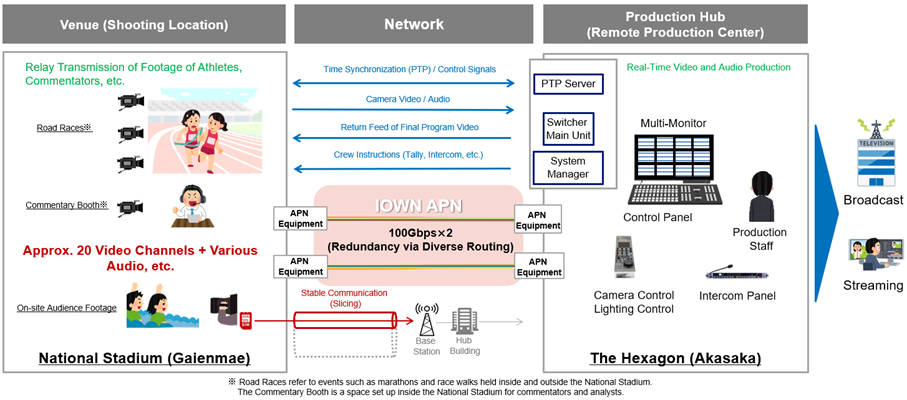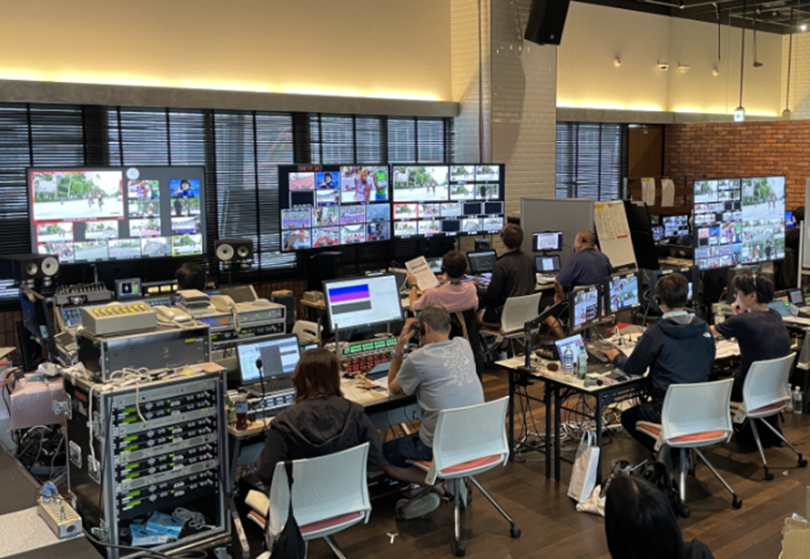Microsoft ends support for Internet Explorer on June 16, 2022.
We recommend using one of the browsers listed below.
- Microsoft Edge(Latest version)
- Mozilla Firefox(Latest version)
- Google Chrome(Latest version)
- Apple Safari(Latest version)
Please contact your browser provider for download and installation instructions.
September 24, 2025
NTT, Inc.
NTT DOCOMO BUSINESS, Inc.
NTT EAST, Inc.
NTT DOCOMO BUSINESS and TBS Television Jointly Establish Remote Production Center
~Utilizing the NTT Group's IOWN APN to conduct terrestrial live broadcasts of large-scale sports events~
News Highlights:
- Achieved remote live production without constraints of scale or distance by utilizing the new remote production center jointly established by TBS Television and NTT DOCOMO BUSINESS.
- Successfully conducted remote production using an uncompressed transmission over the largest IOWN APN in Japan for live broadcast programs of large-scale sports events.
TOKYO - September 24, 2025 - NTT, Inc. (Headquarters: Chiyoda, Tokyo; President and CEO: Akira Shimada; hereinafter "NTT"), NTT DOCOMO BUSINESS, Inc. (Headquarters: Chiyoda, Tokyo; President and CEO: Katsushige Kojima; hereinafter "NTT DOCOMO BUSINESS"), and NTT EAST, Inc. (Headquarters: Shinjuku, Tokyo; President and CEO: Naoki Shibutani; hereinafter "NTT EAST") have successfully utilized remote production for terrestrial live broadcast programs, aiming to improve the efficiency and sophistication of video and audio production (hereinafter referred to as "this initiative"). In this initiative, Tokyo Broadcasting System Television, Inc. (TBS Television) and NTT DOCOMO BUSINESS connected a newly established remote production center (1) with the National Stadium, the filming site, via the IOWN All-Photonics Network (hereinafter "IOWN APN") (2)(3), achieving a flexible production environment that is not limited by the location of the production base.
Background
In video production, remote production, which connects the filming site and the production base via a network, and other video and audio production DX (digital transformation) initiatives face efficiency challenges. Traditionally, many pieces of equipment must be transported to the site using broadcast vehicles, and a large number of staff must be dispatched on location. In addition, these initiatives are expected to help address social issues such as the declining number of video and audio engineers due to population decrease. To make this possible, standardization and consolidation of video and audio production equipment and technologies have been progressing.
For large-scale events held in stadiums or theaters, a significant number of broadcast vehicles and production staff must be deployed on site. Reducing these costs while maintaining a high-quality production environment has been a major challenge.
Overview of the Initiative
In this initiative, TBS Television and NTT DOCOMO BUSINESS connected the newly established remote production center with the National Stadium in Shinjuku, Tokyo, where a large-scale sports event was held, using IOWN APN, which features high capacity, low latency, and stable performance without fluctuations. By connecting video and audio equipment such as switcher panels and mixers at the remote production center via IOWN APN, remote production was achieved, enabling a flexible production environment that is not bound to a specific production base.
The remote production center newly established by TBS Television and NTT DOCOMO BUSINESS was utilized, and IOWN APN was configured using NTT EAST's All-Photonics Connect powered by IOWN (4).
 Figure 1 Conceptual image of remote production utilizing IOWN APN
Figure 1 Conceptual image of remote production utilizing IOWN APN
Key Points of the Initiative
- Remote Production Center
Remote live production that is not limited by the scale or distance targeted by each broadcaster was realized by utilizing the remote production center newly established by TBS Television and NTT DOCOMO BUSINESS. - Utilization of IOWN APN
Remote production using uncompressed transmission over the largest IOWN APN ever in Japan for live broadcast programs of large-scale sports events was successfully achieved.
 Figure 2 Example of utilization at a large-scale sports event
Figure 2 Example of utilization at a large-scale sports event
Outcomes of the Initiative
- Establishment and Operation of the Remote Production Center・ TBS Television and NTT DOCOMO BUSINESS jointly launched a new remote production center. Video and audio from road race events and from a special commentary booth set up inside the National Stadium were transmitted in real time to the remote production center, enabling remote production.・ In addition to transmitting video, audio, camera control signals, and tally (5), the environment enabled remote production of one of the largest events ever held in Japan. This included remote control of cameras and lighting, which require real-time responsiveness and stable operation without fluctuations.・ By using 5G slicing (6) for in-venue video transmission, footage of the audience was captured with highly mobile IP relay equipment. Stable communication was ensured even in crowded conditions, and the captured footage was utilized in the terrestrial live broadcast.
- High Capacity, Low Latency, and Stable IOWN APN・ For the largest live broadcast of a major sports event ever held in Japan, real-time transmission and reception of 20 video channels from the remote site were achieved.・ To ensure uninterrupted live broadcasting, equipment was configured based on SMPTE ST2022-7 (7), one of the standard specifications, and the physical routes of the IOWN APN lines were completely diversified. With the ultra-low latency and stable performance of IOWN APN, fixed delay with no variation was achieved, ensuring high stability with a route delay difference of approximately 60 μs.・ Leveraging the stability of IOWN APN, time synchronization between devices was maintained using PTP (8). This enabled the event to be completed over nine days without a single issue.
 Photo 1 Newly established remote production center
Photo 1 Newly established remote production center
[Comment from TBS Television]
Through the introduction of the remote production center, we have confirmed the technical potential to transform production models for future live sports broadcasts and large-scale events. On-site setup and staff dispatch can be minimized, which may improve efficiency for events held in regional locations or across multiple venues. This has become a model case that promotes technical collaboration and standardization among broadcasters, production companies, and network operators.
Roles of Each Company
This initiative was promoted as a joint effort by the NTT Group and TBS Television.
Future Developments
Going forward, we will jointly explore the commercialization of video and audio production at the remote production center, building on the remote production technologies utilized in this initiative as well as advanced technologies such as 5G millimeter wave that contribute to further enhancements. Through these efforts, we aim to improve the quality of production, advance video and audio production DX, and ensure greater accessibility to audio production bases and filming sites.
In addition, by expanding the IOWN APN technology that underpins this initiative to broadcasters and production sites, we will continue to collaborate in promoting greater efficiency and sophistication in video and audio production across the entire industry through the advancement of production DX.
[Glossary]
1.Remote Production Center
A remote production center is a setup in which video and audio signals from sports or other events held in stadiums or arenas are transmitted via an IP network to a production base (center) located remotely. Program production tasks such as switching and mixing are then carried out remotely.
2.IOWN
The IOWN (Innovative Optical and Wireless Network) is an initiative for networks and information processing infrastructure including terminals that can provide high-speed, high-capacity communication utilizing innovative technology focused on optics, as well as tremendous computational resources. For details, please visit:
■ What is the IOWN Initiative?
https://www.rd.ntt/e/iown/
3.IOWN APN
IOWN APN is the communications infrastructure of the future. It is a high-quality all-optical network that responds to increasingly diverse and complex needs by making use of photonics-based technologies in all areas from network to terminal.. For details, please visit:
■ All-Photonics Network
https://www.rd.ntt/e/iown/0002.html
4.All-Photonics Connect powered by IOWN
"All-Photonics Connect" is a service that connects customer-specified sites point-to-point and provides high-speed, large-capacity, low-latency, and energy-efficient communication at 10 Gbps, 100 Gbps, 400 Gbps, or 800 Gbps. For details, please visit:
■ About All-Photonics Connect powered by IOWN
https://business.ntt-east.co.jp/service/koutaiikiaccess/ (Japanese)
5.Tally
A tally is a lamp attached to a camera or monitor that visually indicates when recording or broadcasting is in progress.
6.5G Slicing
5G slicing is a technology in 5G SA (standalone) that allows a network to be virtually divided (sliced) to provide services tailored to a wide variety of needs. 5G SA is a communication method that combines 5GC (5G Core), which is dedicated core network equipment for 5G, with 5G base stations.
7.SMPTE ST2022-7
SMPTE ST2022-7 is a standard established by SMPTE (Society of Motion Picture and Television Engineers) concerning network redundancy (Hitless Protection) when transmitting broadcast program material signals over an IP network.
8.PTP
PTP (Precision Time Protocol) is a time synchronization standard for networks that enables highly accurate synchronization on the order of microseconds (one-millionth of a second).
About NTT
NTT contributes to a sustainable society through the power of innovation. We are a leading global technology company providing services to consumers and businesses as a mobile operator, infrastructure, networks, applications, and consulting provider. Our offerings include digital business consulting, managed application services, workplace and cloud solutions, data center and edge computing, all supported by our deep global industry expertise. We are over $90B in revenue and 340,000 employees, with $3B in annual R&D investments. Our operations span across 80+ countries and regions, allowing us to serve clients in over 190 of them. We serve over 75% of Fortune Global 100 companies, thousands of other enterprise and government clients and millions of consumers.
Media contacts
NTT, Inc.
NTT IOWN Integrated Innovation Center
Public Relations
Inquiry form
NTT DOCOMO BUSINESS, Inc.
Public Relations, Corporate Planning
Mail: pr-cp@ntt.com
NTT EAST, Inc.
Public Relations Office, Corporate Strategy Planning Department
TEL: 03-5359-3711
Mail: houdou-gm@east.ntt.co.jp
Information is current as of the date of issue of the individual press release.
Please be advised that information may be outdated after that point.
NTT STORY
WEB media that thinks about the future with NTT










